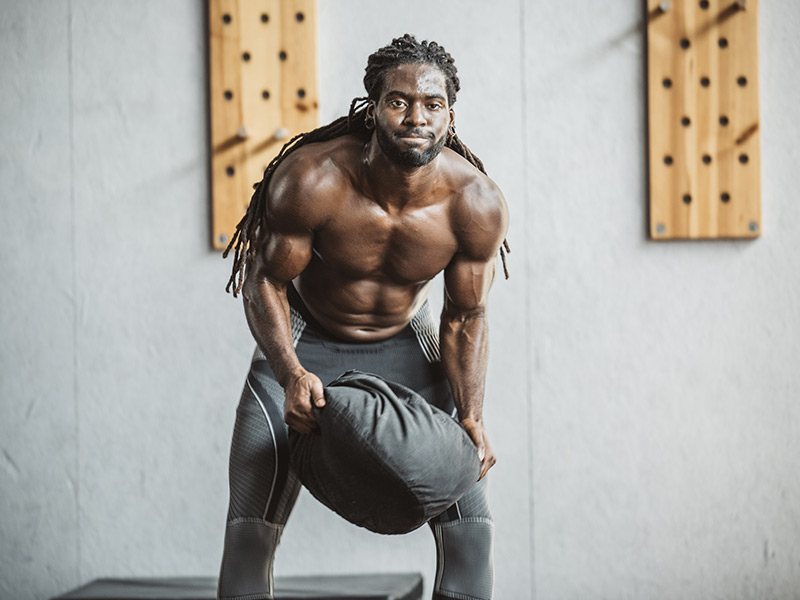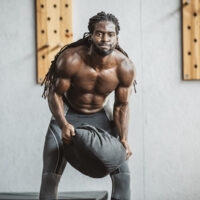Hall of Fame powerlifter Brad Gillingham shares his approach to enhancing training routines by incorporating heavy strength and conditioning circuits.
In efforts to mix up my own training, and challenge some of the athletes that I work with, I incorporate several different heavy strength and conditioning circuits into my training. Most of my years in strength athletics has been spent competing in powerlifting. However, I decided many years ago that I needed to train more than just the squat, bench, and deadlift.
Developing Athleticism
Training heavy strength and conditioning circuits will help you develop more strength endurance and athleticism. Over the years I have devised several different circuits or gauntlets that have roots in strongman, Crossfit, and traditional circuit training.
Unlike fitness orientated circuit training, these heavy strength and conditioning circuits tax entire muscle groups culminating in an exhausting full body workout. Combinations that I use often include sled (pulls pushes drags), farmers walks, sandbag (loads, squats, carries), log press, cleans, deadlifts, squats, pushups, pull up ladders, ball slams and many more. These heavy circuits may serve as their own training session or as a metabolic finisher at the end of a workout.
Enter the Skriptnoid
Programming heavy strength and conditioning circuits is going to depend on your training focus and the availability of equipment and gym space. A couple of years ago I started calling my favorite heavy strength and conditioning circuit the Skriptnoid. To be honest it was just a goofy name I made up years ago, but I eventually turned it into an acronym: Strength, Conditioning, Repetitive, Power, Training; with Neuro-priming, Optimal, Intensity, Delivery.
The Skriptnoid is 10 rounds of
- (5) Ball slams
- (1) Log Clean and Press
- (1) Deadlift
- (1) Heavy Sandbag load
- finished with a Rogue dogsled (rope-pull and push) and/or farmers walk (dependent on the size of group, half of the rounds may be completed with farmers walks.)
We try to complete this circuit in 30-35 minutes. You’re not going to find much research available on setting up these kinds of programs, and surely nobody else is calling this one Skriptnoid. This program just simply works, and we have a great time cranking this one out to our favorite heavy metal, country rock collection! It is a brutal circuit that makes you stronger, gives you more endurance, and makes you mentally tough.
Research indicates that the addition of strongman exercises into your training helps to keep athletes motivated to train harder, and if you keep everyone motivated you’ve won half the battle.1 This is not a peaking program for a world class powerlifter, but rather a strength and conditioning program for athletes training for sport. However, you will get stronger, and find yourself in much better condition if you increase your load intensity over time. It is the importance to choose an optimal level of load intensity. Not too heavy to start with, but cycling up and down the intensity over time.
Now let’s break down the movements.
Ball Slam
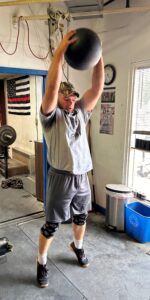 The Skriptnoid always starts with ball slams. We like to start things off by neuro-priming the beast. I prefer to use a 25–30 lb. slam ball. We use near max effort to slam these down as hard as we can for 5 repetitions. Slam balls are different from medicine balls as they are designed not to bounce, but the goal is to slam it down hard enough to can catch it off of the slight bounce.
The Skriptnoid always starts with ball slams. We like to start things off by neuro-priming the beast. I prefer to use a 25–30 lb. slam ball. We use near max effort to slam these down as hard as we can for 5 repetitions. Slam balls are different from medicine balls as they are designed not to bounce, but the goal is to slam it down hard enough to can catch it off of the slight bounce.
Slam balls are a full body plyometric movement that fire up the nervous system and add a great conditioning component. Additionally, research indicates that high intensity muscle actions help to improve maximal performance.2 By starting with ball slams we are starting each round by cranking up the mental intensity and getting in some explosive conditioning work. Additionally, I often complete my standard squat, bench, and deadlift workouts by slamming a ball right before the set.
Log Clean and Press
 The strongman log is a great full body implement that taxes legs, glutes, lats, traps, shoulders triceps and a whole bunch of supportive muscles. I like to use logs when available. They are less technique orientated than a standard barbell clean, and I think they develop more brute strength. They also put a high demand on core stability.
The strongman log is a great full body implement that taxes legs, glutes, lats, traps, shoulders triceps and a whole bunch of supportive muscles. I like to use logs when available. They are less technique orientated than a standard barbell clean, and I think they develop more brute strength. They also put a high demand on core stability.
We start with lightest lifters first on the logs, and progress by increasing the loads as the stronger lifters move down the order. The last lifter then strips the log down to the lightest load. I don’t have access to strongman logs at the college so we substitute with hang clean and press using 4 platforms with various loads. 135-165-185-225 and keep 10 lb. plates nearby for easy adjustment. This is a great substitute, but I do prefer the strongman log and its neutral grip. We are not trying to use max intensities and have no intention of trying to set any records. We keep the load in the 70%-80% 1RM range.
Deadlift
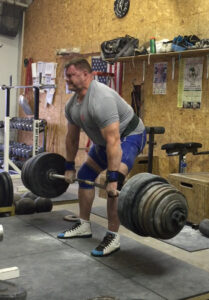 How can you have a full body heavy strength and conditioning circuit without including the deadlift? The deadlift incorporates just about every muscle in your body including the glutes hamstrings, quadriceps, traps, lats, lower back, ,calves, forearms, and grip. The importance of training the deadlift is backed up by scientific research..
How can you have a full body heavy strength and conditioning circuit without including the deadlift? The deadlift incorporates just about every muscle in your body including the glutes hamstrings, quadriceps, traps, lats, lower back, ,calves, forearms, and grip. The importance of training the deadlift is backed up by scientific research..
A meta-analysis analyzed 19 studies that were performed on the deadlift to measure muscular activation with surface electromyography (sEMG). The study indicated that the deadlift and its variations are a very effective primary exercise to maximize quadriceps, hamstrings, and lower back development for athletic performance, health benefits, and rehabilitation.3
We keep the deadlift in the 70%-80 % range and set up as many bars as needed that can be easily changed on the fly. At Jackals Gym this might mean two bars with base loads of 315 and 425 lbs. Weight can quickly be added to either bar to increase the load. For example: throwing 2-35 lb. plates on each side over the 425 quickly brings the load up to 565 of roughly 80% of 700. At the college we set up 4 platforms with loads ranging from 275-315-365-405 and we also keep plates laying close by for quick load adjustment.
Sandbag Load
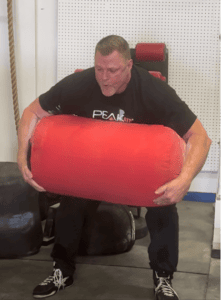 The next movement in the Skriptnoid following the deadlift is a heavy sandbag load. This can be accomplished by loading the sandbag to a box or simply picking it up high and dropping it. Similar to the deadlift, sandbag loading is a total body exercise with lots of emphasis on the posterior chain, quadriceps, biceps, forearms, and grip.
The next movement in the Skriptnoid following the deadlift is a heavy sandbag load. This can be accomplished by loading the sandbag to a box or simply picking it up high and dropping it. Similar to the deadlift, sandbag loading is a total body exercise with lots of emphasis on the posterior chain, quadriceps, biceps, forearms, and grip.
Training with sandbags increases strength endurance, hip extension strength, upper back strength, core strength and they make you mentally tough. I really enjoy training with sandbags. They add a different element of raw strength to your training. We have sandbags ranging from 50 lbs. up to 350 lbs. at the gym so it is very easy to alter the weight to accommodate different strength levels.
Sled Rope Pull and Push
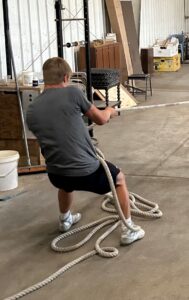
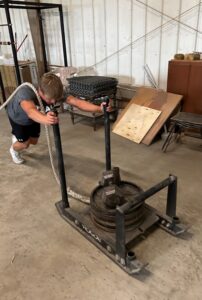 The final exercise is the sled rope-pull and push. This is a great combination to increase the heart rate and tax the entire body. This exercise is completed by pulling the sled 15-20 yards to you, and then pushing it back to the original spot. It is easy to change loads at the end of the run by adding plates or placing dumbbells on top of the stack. At Jackals Gym we have 4-70 lb. dumbbells at the end point. These can be gradually added to the top of the weight stack.
The final exercise is the sled rope-pull and push. This is a great combination to increase the heart rate and tax the entire body. This exercise is completed by pulling the sled 15-20 yards to you, and then pushing it back to the original spot. It is easy to change loads at the end of the run by adding plates or placing dumbbells on top of the stack. At Jackals Gym we have 4-70 lb. dumbbells at the end point. These can be gradually added to the top of the weight stack.
The sled rope-pull trains the grip, forearms back, shoulders, arms, and core stability. Pushing the sled is a great lower body workout and will put the glutes, quads, and calves to work. The combination of the two are a great conditioning component to the circuit, and will improve full body strength and mental toughness..
Farmers Walk
The sled push and pull takes the longest time, and may create a delay, so for larger groups we will alternate the farmers walk with the sled push and pull in order to keep the circuit moving. Half of the group will do sleds the first 5 rounds and half of the group will do farmers walks. Both groups will switch exercises on round 6.
Farmers walks are a staple event in strongman competitions. They are a loaded carry that tax your legs, back, traps forearms, grip, and core. We perform these with plate loaded Rogue farmers walk implements. Similar to a trap bar deadlift the implements are picked up at the side, but rather than set them down they are carried for a distance of 15-20 yards. Similar to the deadlift we do not use max effort weight but stay in the 70-80% range.
Setting up the Heavy Strength and Conditioning Circuit
In a group setting you need implements that are easily adjustable. You need to be able to add or takeoff weight on the fly. We use a timer to keep the circuit moving. You will need a large selection of various weighted sandbags, and may need to set up a couple different deadlift bars. You have to be able to easily adjust the weight on the sleds, farmers walks, log press, deadlift, and sandbags to accommodate different strength levels. It is important to not have people standing around waiting for equipment; rest periods can be built in at the end of each round.
We generally stay in the 70-80% range in the log press, and deadlift. You will need space to accommodate the size of the group. When I run the Skriptnoid during college wrestling season we set up 3 sleds in the hallway outside of the weight room. In the weight room we will utilize 4 platforms for cleans and 4 platforms for deadlifts. We also have half of the group alternate farmers walk for the first 5 rounds so that we don’t have people standing around waiting to use the sleds. At Jackals gym we utilize warehouse space attached to the gym for sleds/farmers walks, and we set up as many log press and deadlift stations as necessary. With some planning it is possible to run numerous athletes through these circuits at the same time. We have 25+ wrestlers going during our pre-season training.
Add Variety to your Workouts and Stay Motivated
It is always important to add some variety to your workouts to stay motivated. Heavy strength and conditioning circuits are a fun way to simultaneously work on strength and conditioning in a group setting. They add variety to your workouts and help you stay motivated to work hard. We’re hitting everything with the Skriptnoid: strength, conditioning, power, mobility, and mental toughness. There is no set recipe on setting up these circuits, and you don’t have to be Zydrunas Savickas or Magnus Ver Magnusson to incorporate strongman movements into your training. Be creative with the equipment you have available, and have some fun. Today is a great day to incorporate the Skriptnoid. Good Luck and Stay Strong!
Optimize Your Recovery from Intense Training Sessions with myHMB®!
When you push your limits in training, our muscle breaks down. With myHMB® you can mitigate muscle damage and speed recovery so you can get back to training and continue to see gains. Learn how myHMB® can help optimize your training performance, click here.
References
-
Winwood PW, Cronin JB, Posthumus LR, Finlayson SJ, Gill ND, Keogh JWL. Strongman vs. traditional resistance training effects on muscular function and performance. Journal of Strength and Conditioning Research. 2015;29(2):429-439. doi:10.1519/jsc.0000000000000629
-
Andrade D, Henriquez-Olguin C, Beltran A, et al. Effects of general, specific, and combined warm-up on explosive muscular performance. Biology of Sport. 2014;32(2):123-128. doi:10.5604/20831862.1140426
-
Martín-Fuentes I, Oliva-Lozano JM, Muyor JM. Electromyographic activity in deadlift exercise and its variants. A systematic review. PLOS ONE. 2020;15(2). doi:10.1371/journal.pone.0229507

